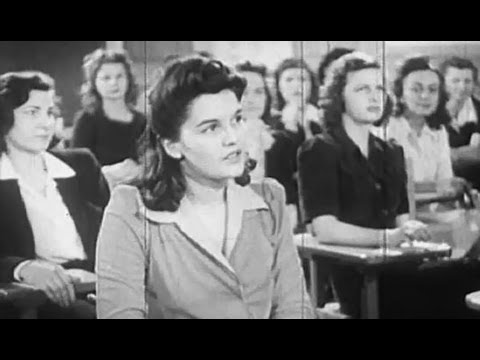Wartime Nutrition 1943 US Office of War Information; Eating Right during World War II Food Rationing
more at
Public domain film from the Library of Congress Prelinger Archive, slightly cropped to remove uneven edges, with the aspect ratio corrected, and mild video noise reduction applied.
The soundtrack was also processed with volume normalization, noise reduction, clipping reduction, and/or equalization (the resulting sound, though not perfect, is far less noisy than the original).
…By summer 1941 the Office of Price Administration believed… that with factories converting to military production and consuming many critical supplies, rationing would become necessary…
Tires were the first item to be rationed by the OPA, which ordered the temporary end of sales on 11 December 1941…
Civilians first received ration books—War Ration Book Number One, or the “Sugar Book”—on 4 May 1942, through more than 100,000 schoolteachers, PTA groups, and other volunteers. A national speed limit of 35 miles per hour was imposed to save fuel and rubber for tires… To get a classification and rationing stamps, one had to appear before a local War Price and Rationing Board which reported to the OPA (which was jokingly said to stand for “Only a Puny A-card”)… An A sticker on a car was the lowest priority of gasoline rationing and entitled the car owner to 3 to 4 gallons of gasoline per week. B stickers were issued to workers in the military industry, entitling their holder up to 8 gallons of gasoline per week. C stickers were granted to persons deemed very essential to the war effort, such as doctors. T rations were made available for truckers. Lastly, X stickers on cars entitled the holder to unlimited supplies and were the highest priority in the system. Ministers of Religion, police, firemen, and civil defense workers were in this category. A scandal erupted when 200 Congressmen received these X stickers.
As of 1 March 1942 dog food could no longer be sold in tin cans, and manufacturers switched to dehydrated versions. As of 1 April 1942 anyone wishing to purchase a new toothpaste tube had to turn in an empty one. Sugar was the first consumer commodity rationed, with all sales ended on 27 April 1942 and resumed on 5 May with a ration of one half pound per person per week, half of normal consumption. Bakeries, ice cream makers, and other commercial users received rations of about 70% of normal usage. Coffee was rationed nationally on 29 November 1942 to one pound every five weeks, about half of normal consumption, in part because of German U-boat attacks on shipping from Brazil. By the end of 1942 ration coupons were used for nine other items. Typewriters, gasoline, bicycles, footwear, Silk, Nylon, fuel oil, stoves, meat, lard, shortening and oils, cheese, butter, margarine, processed foods (canned, bottled, and frozen), dried fruits, canned milk, firewood and coal, jams, jellies, and fruit butter were rationed by November 1943. Many retailers welcomed rationing because they were already experiencing shortages of many items due to rumors and panics, such as flashlights and batteries after Pearl Harbor.
Medicines such as penicillin were rationed by a triage committee at each hospital.
Many levels of rationing went into effect. Some items, such as sugar, were distributed evenly based on the number of people in a household. Other items, like gasoline or fuel oil, were rationed only to those who could justify a need. Restaurant owners and other merchants were accorded more availability, but had to collect ration stamps to restock their supplies. In exchange for used ration stamps, ration boards delivered certificates to restaurants and merchants to authorize procurement of more products…
Each ration stamp had a generic drawing of an airplane, gun, tank, aircraft carrier, ear of wheat, fruit, etc. and a serial number. Some stamps also had alphabetic lettering. The kind and amount of rationed commodities were not specified on most of the stamps and were not defined until later when local newspapers published, for example, that beginning on a specified date, one airplane stamp was required (in addition to cash) to buy one pair of shoes and one stamp number 30 from ration book four was required to buy five pounds of sugar. The commodity amounts changed from time to time depending on availability. Red stamps were used to ration meat and butter, and blue stamps were used to ration processed foods.
To enable making change for ration stamps, the government issued “red point” tokens to be given in change for red stamps, and “blue point” tokens in change for blue stamps. The red and blue tokens were about the size of dimes (16 mm) and were made of thin compressed wood fiber material, because metals were in short supply.
As a result of the rationing, all forms of Automobile racing, including the Indianapolis 500, were banned. Sightseeing driving was also banned.
Rationing was ended in 1946…

